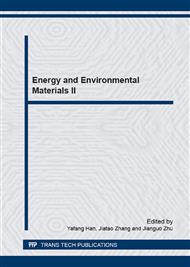[1]
D.L. He, F.Q. Dong, Y.J. Luo, L.L. Huang, B.S. Zhang, Preparation of spherical calcium carbonate from phosphorus slag, J. Chin. Ceramic. Soc. 38(2010)1568–1273.
Google Scholar
[2]
G. Hadiko, Y.S. Han, M. Fuji, M. Takahashi, Synthesis of hollow calcium carbonate particles by the bubble templating method, Mater. Lett. 59(2005) 2519–2522.
DOI: 10.1016/j.matlet.2005.03.036
Google Scholar
[3]
S.E. Grasby, Naturally precipitating vaterite (-μ-CaCO3) spheres: Unusual carbonates formed in an extreme environment, Geochim. Cosmochim. AC. 67(2003)1659-1666.
DOI: 10.1016/s0016-7037(02)01304-2
Google Scholar
[4]
H.A. Lowenstam, D.P. Abbott, Vaterite: a mineralization product of the hard tissues of a marine organism(Ascidiacea), Science. 188(1975)363–365.
DOI: 10.1126/science.1118730
Google Scholar
[5]
AllenL, Rodgers, Common ultrastructural features in human calculi, Micron and Microsc. Acta. 14(1983)219–224.
DOI: 10.1016/0047-7206(83)90052-3
Google Scholar
[6]
A. Vecht, T.G. Ireland, The role of vaterite and aragonite in the formation of pseudo-biogenic carbonate structures: Implications for Martian exobiology, Geovhim. Cosmochim. AC. 64(2000) 2719–2725.
DOI: 10.1016/s0016-7037(00)00381-1
Google Scholar
[7]
R.J. Liu, Y.Z. Gao, C.Z. Gao, S.X. Gao, China. Patents. CN102701225A. (2012).
Google Scholar
[8]
Q.L. Gu, Y.K. Xu, F.F. Gu, J.L. Jung, Z.J. Gu, B.X. Ni, J.J. Gao, J.Y. Cao, X.T. Zhang, S.J. Tao, China. Patents. CN10301125A. (2013).
Google Scholar
[9]
S.F. Chen, S.H. Yu, J. Jiang, F.Q. Li, Y.K. Liu, Polymorph discimination of CaCO3 mineral in an ethanol/water solution: formation of complex vaterite superstructures and aragonite rods, Chem. Mater. 18(2006)115–122.
DOI: 10.1021/cm0519028
Google Scholar
[10]
N. Hosoda, A. Sugawara, T. Kato, Template effect of crystalline poly(vinyl alcohol)for selective formation of aragonite and vaterite CaCO3 thin films, Macromolecules. 36(2003) 6449–6452.
DOI: 10.1021/ma025869b
Google Scholar
[11]
R.J. Qi, Y.J. Zhu, Microwave-assisted synthesis of calcium carbonate (vaterite)of various morphologies in water-ethylene glycol mixed solvents, Phys. Chem. B. 110(2006) 8302–8306.
DOI: 10.1021/jp060939s
Google Scholar
[12]
A. Yashchenok, B. Parakhonskiy, S. Donatan,D. Kohler, A. Skirtach, H. Möhward, Polyelectrolyte multilayer microcapsules template on spherical, elliptical and square calcium carbonate particles, J. Mater. Chem. B. 1(2013)1223–1228.
DOI: 10.1039/c2tb00416j
Google Scholar
[13]
S.L. Yang, W. Song, Study on Precipitation Process of Spherical Calcium Carbonate Controlled by Polyaspartic Acid, J. Synth. Cryst. 42(2013)1475–1480.
Google Scholar
[14]
J.G. Yu, X.F. Zhao, B. Cheng Q.J. Zhang, Controlled synthesis of calcium carbonate in a mixed aqueous solution of PSMA and CTAB, J. Solid. State. Chem. 178(2005)861–867.
DOI: 10.1016/j.jssc.2005.01.002
Google Scholar
[15]
R.N. Carlos, J.L. Concepcion, R.N. Alejandro, G.M. Maria Teresa, R.G. Manuel, Bacterially mediated mineralization of vaterite, Geochimi. Cosmochim. AC. 71(2007)1997–1213.
Google Scholar
[16]
H. Watanabe, Y. Mizuno, T. Endo, X.W. Wang, M. Fuji, M. Takahashi, Effect of initial pH on formation of hollow calcium carbonate particles by continuous CO2 gas bubbing into CaCl2 aqueous solution, Adv. Powder. Technol. 20(2009)89–93.
DOI: 10.1016/j.apt.2008.10.004
Google Scholar
[17]
E. Dalas, P.G. Koutsoukos, Calcium carbonate scale formation on heated metal surfaces, Geothermics. 18(1989)83–88.
DOI: 10.1016/0375-6505(89)90013-8
Google Scholar
[18]
Y.S. Han, G. Hadiko, M. Fuji, M. Takahashi, Crystallization and transformation of vaterite at controlled pH, J. Synth. Cryst. 289(2006)269–274.
DOI: 10.1016/j.jcrysgro.2005.11.011
Google Scholar
[19]
M. Subba-Rao, Kinetics and mechanism of the transformation of vaterite to calcite, Bull. Chem. Soc. Jan. 46(1973)1414–1417.
Google Scholar


